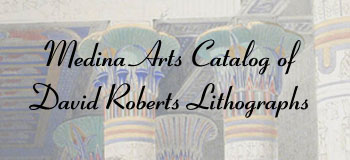


How best to conserve antique lithographs in general is a subject of much discussion and many different views. Whether and how to clean them to remove various types of age related deterioration generates perhaps the strongest views. Any discussion of such cleaning and conservation options for first edition David Roberts lithographs best begins with a description of the most common types of damage and deterioration a collector might encounter.
Toning - Generally, this is a darkening of the paper, sometimes concentrated along the edges only, and sometimes over the entire print. Below is an SE print of Entrance of the Temple of Amun, Thebes which displays both significant overall toning and severe trimming of the margins. The image beneath it had the same degree of toning before being cleaned. Such toning may result from exposure to light over a long period, or such environmental issues as cigarette or cigar smoke. Paper, particularly wood pulp paper, tends to become more acidic over time, and this can accelerate toning. The toning is often worse on the edges of the print, and margins are sometimes cropped in an effort to remove this damage.
Foxing - Sometimes called "foxmarks", these are circular or oval brown spots. They are thought to result from impurities in the paper, such as metal residues, which over time discolor the areas around them. Acidification of the paper may also contribute to foxing. Below is a portion of an SE lithograph showing these foxmarks. In addition to the foxing, some minor toning is evident at the very edges of the margins. Generally, foxing is one of the easier discolorations to remove by cleaning.
Tidemarks - Tidemarks result from water soaking into the paper and wicking along its surface. Just as the ocean tide leaves a line of debris on the sand at its high water mark, water in the paper leaves a line of discoloration at the edge of its penetration. As the water soaks the paper, it dissolves materials in it and carries them to the edge of the wet area, leaving a noticeable line as it dries and recedes. Below is an SE lithograph displaying a tide mark in its upper left corner. Tide marks can be more difficult to clean than toning or foxing, but usually can be removed.